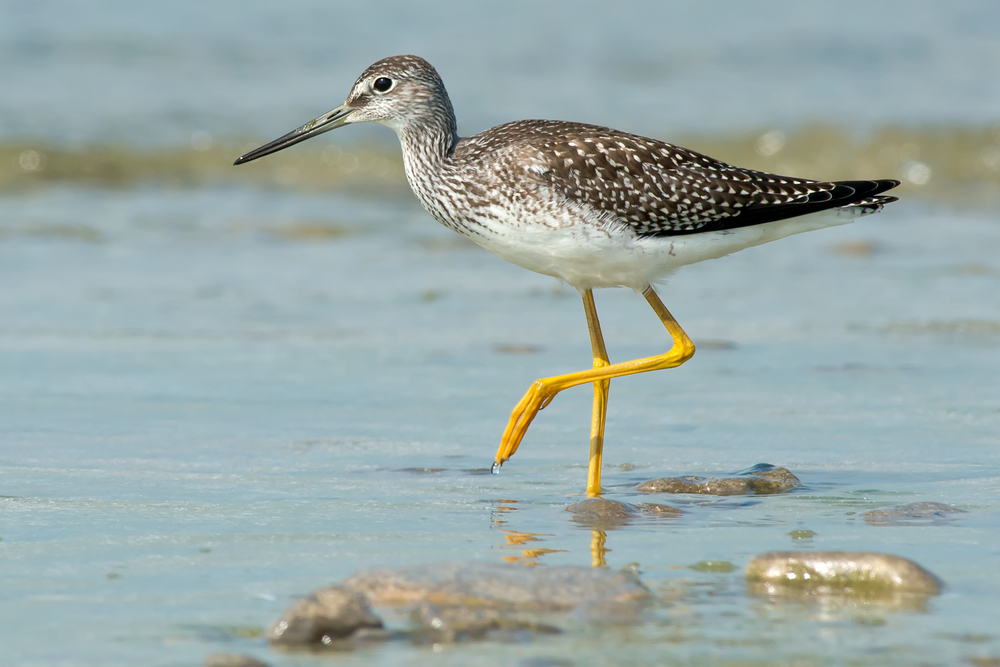
The Bay of Fundy is a key resting and refuelling stopover for millions of migrating shorebirds headed to their wintering grounds. These birds begin to appear in the Bay of Fundy’s intertidal and coastal areas in early July, steadily increasing until mid-August, when massive flocks of birds can be found swooping through the region’s skies and roaming around its isolated beaches and tidal mud flats. More than 20 of Canada’s shorebird species pass through Atlantic Canada along their migration, but these are 10 of the most common. To learn more about the Bay of Fundy and the abundance of wildlife this incredible ecosystem supports, catch Season 2 of Undiscovered Vistas on Love Nature.
Semipalmated Sandpiper

Although a number of bird species pass through the Bay of Fundy during the fall migration, the semipalmated sandpiper is by far the most abundant. This small, sparrow-sized shorebird visits the upper Bay of Fundy each year from July through October, when food sources are plentiful. Mudshrimp, for example, peak when this bird makes its pitstop on the way to its wintering grounds in South America.
Short-billed Dowitcher

This small- to medium-sized shorebird favours mudflats, tidal marshes and pod edges. It has a long, narrow beak that allows it to use a “sewing machine” method to forage for food in environments like these, including the Bay of Fundy. Given this, the name of the species may seem misleading, but not when its compared to the long-billed dowitcher.
Semipalmated plover

This small shorebird can be easily identified by the single black band that wraps around its neck. These migratory birds breed on beaches or flats in northern Canada and Alaska, and winter in the southern U.S. and Caribbean, with some populations stopping over in the Bay of Fundy along the way. During migration, this bird will swim short distances across small channels to forage for food on beaches, tidal flats, and in fields.
Black-bellied plover

This relatively large shorebird might appear a little plain during migration compared to the stark black belly it sports in breeding season, but it’s still quite conspicuous among other shorebird species due to its size. Although it’s commonly found in the Bay of Fundy during its migration period, the black-bellied plover is one of the most wide-ranging shorebird species out there. It breeds anywhere from Western Alaska through the Canadian Arctic Archipelago before moving south to overwinter along the Atlantic and Pacific Coasts of North America.
Red knot

This chunky shorebird sports a red belly in the spring, when it migrates from Argentina to the Canadian Arctic. Travelling up to 15,000 kilometres, the red knot makes one of the longest yearly migrations of any other bird. Along the way, they fatten up at stopovers, like the Bay of Fundy and other tidal flats, where they can gorge on things like crab eggs before continuing their journey north.
White-rumped sandpiper

True to its name, the white-rumped sandpiper can be distinguished from other flocks of small shorebirds based on its rear and distinctive call. The white patch above its tail is sometimes hidden by its long wings, which are indicative of its annual migrations from Canada’s Arctic to the southern tip of South America and sometimes even a few islands near the Antarctic Peninsula.
Sanderling

Sanderlings are often easy to recognize as they run up and down beaches searching for tiny prey in the wet sand, which are left behind by receding waves. These medium-sized sandpipers’ obsessive wave-chasing habits distinguish them from other sandpipers far more than their pale nonbreeding plumage, black legs and bill. During migration season, these plump, active shorebirds are common sights on beaches around the world, including the Bay of Fundy.
Dunlin

The Dunlin is a common shorebird around the world, recognized by its bright reddish back and black belly during breeding season, and its long, drooping bill. These birds are also known for their impressive aerial maneuvers, as they twist and bank in unison. Dunlin molt before starting their fall migration south, which means that both adults and juveniles migrate to temperate coastal regions of North America around the same time.
Ruddy turnstone

Wearing a bright harlequin pattern in the summer, this chunky, short-legged sandpiper can look more like a calico cat than a shorebird. They breed in the high arctic tundra of North America and Eurasia, migrating long-distances to spend their off-season on the rocky, sandy shores of six different continents. Along the way, they can be found on coasts and favourite inland spots, like the Great Lakes.
Greater yellowlegs

This tall long-legged shorebird is common on the coasts of North America during migration. It announces its presence with a piercing alarm call that can sometimes spook other shorebirds. If it hasn’t already made its presence known, the greater yellowlegs often draws attention to itself in the freshwater ponds and tidal marshes it roams, bobbing its head up and down and calling loudly so onlookers keep their distance.
